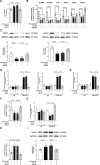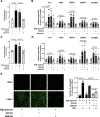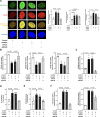Repressive H3K27me3 drives hyperglycemia-induced oxidative and inflammatory transcriptional programs in human endothelium
- PMID: 38580969
- PMCID: PMC10998410
- DOI: 10.1186/s12933-024-02196-0
Repressive H3K27me3 drives hyperglycemia-induced oxidative and inflammatory transcriptional programs in human endothelium
Abstract
Background: Histone modifications play a critical role in chromatin remodelling and regulate gene expression in health and disease. Histone methyltransferases EZH1, EZH2, and demethylases UTX, JMJD3, and UTY catalyse trimethylation of lysine 27 on histone H3 (H3K27me3). This study was designed to investigate whether H3K27me3 triggers hyperglycemia-induced oxidative and inflammatory transcriptional programs in the endothelium.
Methods: We studied human aortic endothelial cells exposed to high glucose (HAEC) or isolated from individuals with diabetes (D-HAEC). RT-qPCR, immunoblotting, chromatin immunoprecipitation (ChIP-qPCR), and confocal microscopy were performed to investigate the role of H3K27me3. We determined superoxide anion (O2-) production by ESR spectroscopy, NF-κB binding activity, and monocyte adhesion. Silencing/overexpression and pharmacological inhibition of chromatin modifying enzymes were used to modulate H3K27me3 levels. Furthermore, isometric tension studies and immunohistochemistry were performed in aorta from wild-type and db/db mice.
Results: Incubation of HAEC to high glucose showed that upregulation of EZH2 coupled to reduced demethylase UTX and JMJD3 was responsible for the increased H3K27me3. ChIP-qPCR revealed that repressive H3K27me3 binding to superoxide dismutase and transcription factor JunD promoters is involved in glucose-induced O2- generation. Indeed, loss of JunD transcriptional inhibition favours NOX4 expression. Furthermore, H3K27me3-driven oxidative stress increased NF-κB p65 activity and downstream inflammatory genes. Interestingly, EZH2 inhibitor GSK126 rescued these endothelial derangements by reducing H3K27me3. We also found that H3K27me3 epigenetic signature alters transcriptional programs in D-HAEC and aortas from db/db mice.
Conclusions: EZH2-mediated H3K27me3 represents a key epigenetic driver of hyperglycemia-induced endothelial dysfunction. Targeting EZH2 may attenuate oxidative stress and inflammation and, hence, prevent vascular disease in diabetes.
Keywords: Chromatin-modifying drugs; Diabetes; EZH2 inhibitor GSK126; Endothelial cells; Epigenetics; Inflammation; Oxidative stress.
© 2024. The Author(s).
Conflict of interest statement
The authors declare that no conflict of interest exists.
Figures





Similar articles
-
Flow-dependent epigenetic regulation of IGFBP5 expression by H3K27me3 contributes to endothelial anti-inflammatory effects.Theranostics. 2018 Apr 30;8(11):3007-3021. doi: 10.7150/thno.21966. eCollection 2018. Theranostics. 2018. PMID: 29896299 Free PMC article.
-
NF-κB-mediated enhancement of H3K27me3 through EZH2: a mechanism to suppress pyocyanin-induced autophagy in macrophages.Eur J Med Res. 2025 Apr 29;30(1):346. doi: 10.1186/s40001-025-02614-3. Eur J Med Res. 2025. PMID: 40301947 Free PMC article.
-
Intermittent High Glucose Elevates Nuclear Localization of EZH2 to Cause H3K27me3-Dependent Repression of KLF2 Leading to Endothelial Inflammation.Cells. 2021 Sep 26;10(10):2548. doi: 10.3390/cells10102548. Cells. 2021. PMID: 34685528 Free PMC article.
-
Dysregulation of histone H3 lysine 27 trimethylation in transforming growth factor-β1-induced gene expression in mesangial cells and diabetic kidney.J Biol Chem. 2019 Aug 23;294(34):12695-12707. doi: 10.1074/jbc.RA119.007575. Epub 2019 Jul 2. J Biol Chem. 2019. PMID: 31266808 Free PMC article.
-
Regulation of histone H3K27 methylation in inflammation and cancer.Mol Biomed. 2025 Mar 5;6(1):14. doi: 10.1186/s43556-025-00254-x. Mol Biomed. 2025. PMID: 40042761 Free PMC article. Review.
Cited by
-
ER-α36 prevents high glucose-induced cellular senescence and apoptosis in renal tubular cell.Front Endocrinol (Lausanne). 2025 Jun 9;16:1426854. doi: 10.3389/fendo.2025.1426854. eCollection 2025. Front Endocrinol (Lausanne). 2025. PMID: 40551891 Free PMC article.
-
Epigenetics Plays a Role in the Pathogenesis and Treatment of Diabetes.Genes (Basel). 2025 Jun 30;16(7):769. doi: 10.3390/genes16070769. Genes (Basel). 2025. PMID: 40725425 Free PMC article. Review.
-
Implications of prognostic nutritional index in predicting adverse outcomes of uncontrolled diabetic patients: a cohort study of the national health and nutrition examination survey from 2005 - 2018.Diabetol Metab Syndr. 2024 Dec 30;16(1):315. doi: 10.1186/s13098-024-01563-x. Diabetol Metab Syndr. 2024. PMID: 39734208 Free PMC article.
-
Cardiometabolic disease management: influences from epigenetics.Epigenomics. 2025 May;17(7):463-474. doi: 10.1080/17501911.2025.2489921. Epub 2025 Apr 21. Epigenomics. 2025. PMID: 40255091 Review.
-
Stress hyperglycemia ratio as a biomarker for early mortality risk stratification in cardiovascular disease: a propensity-matched analysis.Cardiovasc Diabetol. 2025 Jul 12;24(1):286. doi: 10.1186/s12933-025-02812-7. Cardiovasc Diabetol. 2025. PMID: 40652236 Free PMC article.
References
-
- Saeedi P, Petersohn I, Salpea P, Malanda B, Karuranga S, Unwin N, et al. Global and regional diabetes prevalence estimates for 2019 and projections for 2030 and 2045: results from the International Diabetes Federation Diabetes Atlas, 9th edition. Diabetes Res Clin Pract. 2019;157:107843. doi: 10.1016/j.diabres.2019.107843. - DOI - PubMed
-
- Alexander Y, Osto E, Schmidt-Trucksäss A, Shechter M, Trifunovic D, Duncker DJ, et al. Endothelial function in cardiovascular medicine: a consensus paper of the European Society of Cardiology Working Groups on Atherosclerosis and Vascular Biology, Aorta and Peripheral Vascular Diseases, Coronary Pathophysiology and Microcirculation, and Thrombosis. Cardiovasc Res. 2021;117:29–42. doi: 10.1093/cvr/cvaa085. - DOI - PMC - PubMed
Publication types
MeSH terms
Substances
LinkOut - more resources
Full Text Sources
Medical
Research Materials
Miscellaneous

